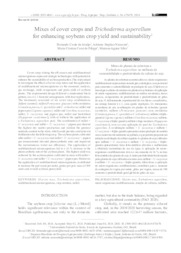Mixes of cover crops and Trichoderma asperellum for enhancing soybean crop yield and sustainability.
Mixes of cover crops and Trichoderma asperellum for enhancing soybean crop yield and sustainability.
Author(s): ARAÚJO, F. C. de; NASCENTE, A. S.; FILIPPI, M. C. C. de; SILVA, M. A.
Summary: Cover crops during the off-season and multifunctional microorganisms represent strategic technologies with potential to enhance the sustainability of soybean production. This study aimed to investigate the effects of cover crop mixes and the application of multifunctional microorganisms on the economic analysis, gas exchange, yield components and grain yield of soybean plants. The experimental design followed a randomized block pattern, in a 6 x 2 factorial arrangement, with four replications. The treatments consisted of six cover crop combinations [fallow (control); millet (Pennisetum glaucum) with crotalarias (Crotalaria juncea, C. spectabilis and C. ochroleuca); millet and pigeon pea (Cajanus cajanus); millet and Urochloa ruziziensis; millet, U. ruziziensis and pigeon pea; millet and buckwheat (Fagopyrum esculentum)], with or without the application of a Trichoderma asperellum pool. The combination of millet + U. ruziziensis and millet + U. ruziziensis + pigeon pea showed the highest dry matter production and yielded the greatest nutrients content in the straw, which could provide a reduction in fertilization for the following crop. The soybean plants cultivated after millet + U. ruziziensis and millet + U. ruziziensis + pigeon pea demonstrated elevated photosynthetic rates and improved the instantaneous water-use efficiency. The application of multifunctional microorganisms led to a 16 % increase in the photosynthetic rate of the soybean plants. The highest yield was achieved by the soybean plants cultivated in areas with millet + U. ruziziensis and millet + U. ruziziensis + pigeon pea. Moreover, the application of multifunctional microorganisms contributed to increase the pod count per meter, grains per pod, mass of 100 seeds and overall soybean grain yield.
Publication year: 2024
Types of publication: Journal article
Unit: Embrapa Rice & Beans
Observation
Some of Embrapa's publications are published as ePub files. To read them, use or download one of the following free software options to your computer or mobile device. Android: Google Play Books; IOS: iBooks; Windows and Linux: Calibre.
Access other publications
Access the Agricultural Research Database (BDPA) to consult Embrapa's full library collection and records.
Visit Embrapa Bookstore to purchase books and other publications sold by Embrapa.

